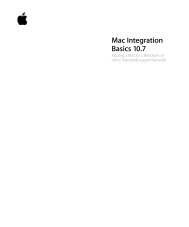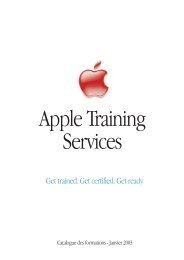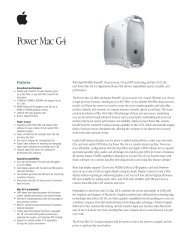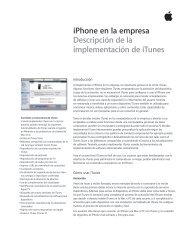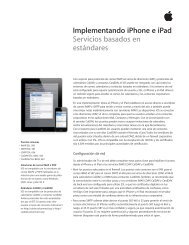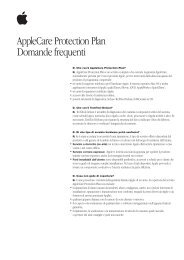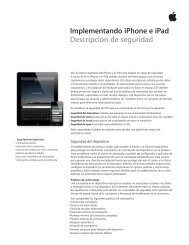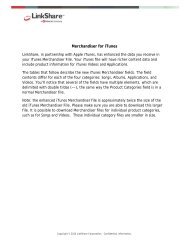In-House App Development Accelerator Guide - Apple
In-House App Development Accelerator Guide - Apple
In-House App Development Accelerator Guide - Apple
You also want an ePaper? Increase the reach of your titles
YUMPU automatically turns print PDFs into web optimized ePapers that Google loves.
Data Security<br />
<strong>In</strong>-house apps can protect sensitive data by taking advantage of the built-in encryption features<br />
available in the latest generations of <strong>App</strong>le devices. Data Protection leverages each user’s unique device<br />
passcode in concert with the hardware encryption on the device to generate a strong encryption key.<br />
When your in-house app designates a particular fi le as protected, the system stores that fi le on the<br />
device in an encrypted format. While the device is locked, the contents of the fi le are inaccessible to<br />
both your app and to any potential intruders. However, when the user unlocks the device, iOS creates<br />
a decryption key that gives your app access to the fi le. You’ll need to design your app to secure the<br />
data as it’s created and to be prepared for changes in accessing that data when the user locks and<br />
unlocks the device.<br />
Secure Authentication<br />
iOS provides a secure, encrypted keychain for storing digital identities, user names, and passwords.<br />
The operating system partitions keychain data so that credentials stored by third-party apps cannot<br />
be accessed by apps with a di∂ erent identity. This enables iOS to secure authentication credentials<br />
across a range of apps and services within the enterprise. <strong>In</strong> iOS, Keychain Services checks an app’s<br />
signature before giving it access to a keychain, handling all keychain access without user interaction.<br />
Your in-house apps can interact with the keychain through the Keychain Services API.<br />
Testing and Validation<br />
Validating testing for performance, UI optimization, network testing, and real-world usability should be<br />
an integral part of your ongoing development process. <strong>In</strong> fact, the motto “test early and often” is key<br />
to a successful iOS app development project. You can ensure that your app design and code are on<br />
track with early testing and validation using a number of methods. The following is a summary of the<br />
iOS testing tools you can use for analysis and debugging.<br />
Static analysis. Find bugs in your code before the application is even run by letting the Xcode built-in<br />
static analyzer try out thousands of possible code paths in a few seconds, reporting potential bugs<br />
that could have remained hidden or nearly impossible to replicate.<br />
On-device real-time debugging. Plug in your device to use the Xcode graphical debugger, or collect<br />
real-time performance data in <strong>In</strong>struments’ timeline view. These powerful optimization tools allow you<br />
to quickly identify and address any performance issues. You’ll be able to see variable values with a<br />
mouse hover.<br />
Planning • Design • <strong>Development</strong> • Deployment<br />
Quick Tip: Authentication Library<br />
An elegant way to implement security in iOS apps is to create a shared<br />
authentication library you can use across all in-house apps. You can<br />
integrate this authentication library with your existing directory services<br />
(LDAP or Active Directory) so that each time you create a new app, you<br />
don’t need to write new authentication code. By storing a credential in the<br />
shared keychain, your user experience is further enhanced because users<br />
don’t have to log in to each app they use. Your library could also defi ne<br />
time-out periods per your internal IT requirements. Sharing this type of code<br />
across internal apps creates consistency in your policies and consistency in<br />
the user experience—a win for both users and IT.<br />
“ We have a single sign-on on all<br />
apps, and we have access-control<br />
lists, on the private ones. So even<br />
if you download it, for single signon,<br />
it’ll pass a parameter over to<br />
our application where we’ll do a<br />
check to see if you have access.<br />
And if you do, great, and if not,<br />
you won’t be able to get into it.”<br />
—James Blomberg, General Electric<br />
24





